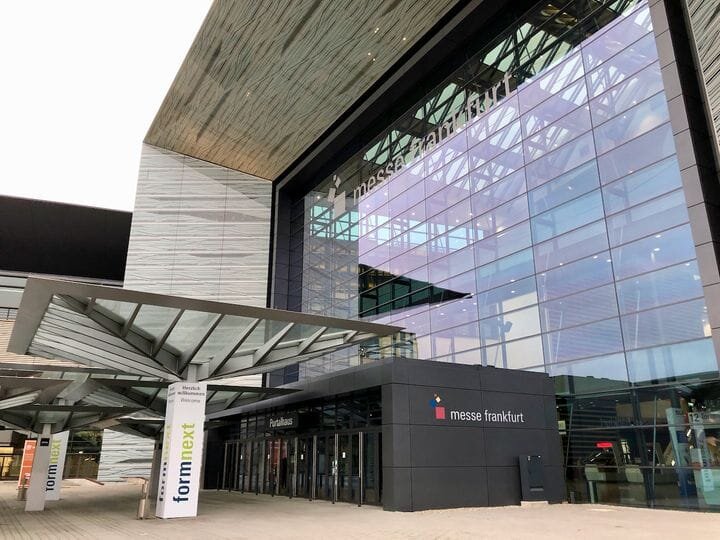![Fancy entranceway to Formnext 2019 [Source: Fabbaloo]](https://fabbaloo.com/wp-content/uploads/2020/05/image-asset_img_5eb08ceb8421f.jpg)
I’ve finally returned from Frankfurt, Germany where our team spent considerable hours exploring the latest 3D printing tech at Formnext 2019.
We have in our possession many dozens of stories to describe the amazing developments we discovered during our lengthy tour of Formnext 2019. (I’ve also managed to catch a virus from one of the hundreds of hands shaken.)
To put this in perspective, we must have received a hundred announcements of new products and services from vendors over the past week or two. Given our news capacity, it’s literally impossible to tell all of them when the vendors intended to announce them.
We’ll be relating them all to you over the next several weeks with accompanying proper analysis, but for now I’d like to discuss the event in general and its progress since it began in 2015.
Formnext Growth
This event took over the fall Frankfurt trade show slot vacated by the now-defunct Euromold, which had run for over 20 years. Now the event is the world’s premiere event for exhibiting 3D printing technology, by a very wide margin.
![Two-story booth from HP at Formnext 2019 [Source: Fabbaloo]](https://fabbaloo.com/wp-content/uploads/2020/05/formnext-2019-hp-1_img_5eb08cebcde66.jpg)
Yes, there are other major 3D printing events, such as Rapid in the USA, but the scale of Formnext is essentially in another universe. Whereas most trade show formats have vendors exhibiting at fold-up tables with a colored cloth on top, the booths at Formnext are now of staggering size. This year there were plenty of two-story booths, with “penthouse” meeting rooms on top. Many were literally made with stone tiles, glass and metal. The Stratasys exhibit in particular was so enormous it actually took a couple of minutes to circumnavigate on foot!
![The Stratasys booth at Formnext 2019 - yes, it extends all the way as shown! [Source: Fabbaloo]](https://fabbaloo.com/wp-content/uploads/2020/05/image-asset_img_5eb08cec48449.jpg)
Not only were the exhibits the largest ever seen in the world of 3D printing and additive manufacturing, there were more of them than at any other event. According to figures released by Mesago, the group behind Formnext, there were 852 exhibitors, an increase of 35%, and 34,532 visitors, an increase of 28%. At this scale, there is no other event of comparable size on the planet showing this technology.
![Gigantic line of attendees entering Formnext 2019 [Source: Fabbaloo]](https://fabbaloo.com/wp-content/uploads/2020/05/image-asset_img_5eb08cec8d000.jpg)
While there are countless stories of interest, I did observe several themes that seemed to emerge as I spoke with vendors from all aspects of 3D printing. Here’s what I saw:
Biocompatible, Eco Friendly 3D Printing Is Coming
Multiple companies described products specifically designed to be biocompatible and/or eco-friendly. We’ve seen some of this before, mostly for sensational value, but never in such a deep and considered way. Several vendors are beginning to introduce such products, and I suspect this effect going to increase tremendously over time, at least in areas where it is possible.
Recognition of Non-3D Printing Activities
![A robotic system handling completed 3D prints [Source: Fabbaloo]](https://fabbaloo.com/wp-content/uploads/2020/05/image-asset_img_5eb08cecd9ba8.jpg)
At Formnext 2019 we saw countless post-processing systems, services and gadgets, indicating an increasing interest in the whole lifecycle of 3D printing. When the printing finishes, the post processing starts and often that’s the major part of the workload. Some exhibitors didn’t even update their printing technology, and simply added non-3D printing workload optimizations. This is a very good change in direction, as equipment buyers must handle all aspects of the work and have been left short of optimal end-to-end solutions in the past.
Chemical Companies Address Additive Manufacturing
While only a few years ago you would not have seen a major chemical company at such an exhibition, it seems many of them are now present. Companies such as BASF, SABIC, DuPont, Mitsubishi and others now routinely exhibit samples from their extensive catalogs of unique resin formulations. Some you may not have expected to see include Loctite and even 3M were present with unique offerings. It now seems big chemical is in the space to stay.
Exclusive Materials for 3D Printing
![A spool of PEEK 3D printing filament [Source: Fabbaloo]](https://fabbaloo.com/wp-content/uploads/2020/05/image-asset_img_5eb08ced37ea1.jpg)
Multiple 3D printer manufacturers have signed agreements with chemical companies for exclusive use of a specific material. This creates a kind of “mini-monopoly” in that if an engineer needed to use that material, then they’d have to buy the manufacturer’s equipment. I’m not sure this is a good long-term strategy, but it could benefit the manufacturer in the short term. For engineers, at least it makes a new material available.
Focus on High Temperature 3D Printing Equipment
![Parts 3D printed in PPSU material [Source: Fabbaloo]](https://fabbaloo.com/wp-content/uploads/2020/05/image-asset_img_5eb08ced87132.jpg)
From only a handful of high temperature 3D printers a year ago, there now seems to be many more. High temperature machines were priced at a premium due to their rarity, but now competition is setting in and we should see prices drop, making high temperature materials available to more businesses.
New Low Cost 3D Printing Processes
![A new 3D printing process can quickly etch circuits on arbitrary geometries [Source: Fabbaloo]](https://fabbaloo.com/wp-content/uploads/2020/05/image-asset_img_5eb08cedd0613.jpg)
There are charts listing the known 3D print processes, but they seem to get longer each year. This year I witnessed several new processes that each had the promise of dramatically lowering the price of 3D printing metal or plastic objects. It’s obviously not yet clear these new processes will survive, but the message is clear: 3D printing is only at the beginning and there is much road left to travel.

